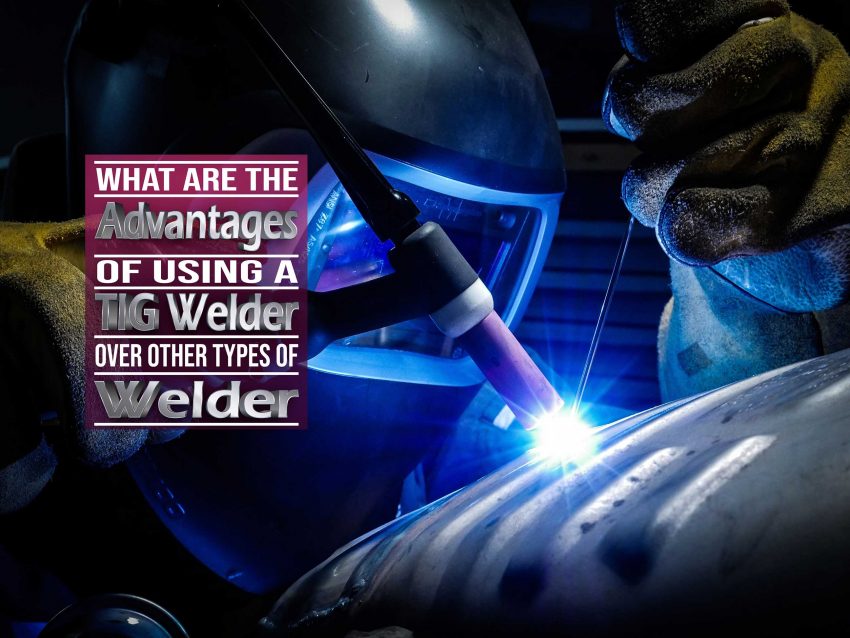Tons of people use Tungsten Inert Gas (TIG) or Gas Tungsten Arc Welding (GTAW) as their primary welding method. You might wonder what are the advantages of using a TIG welder over other types of welder.
TIG welding offers benefits in terms of versatility and amperage. It requires less energy to perform welding compared to other welding methods. This welding process leaves a clean weld by making a low-profile weld bead. Moreover, you will get a slag-free result once the process is completed.
Let’s jump right in to know why TIG welding is useful.
What are the Advantages of Using a TIG Welder over Other types of Welder?
Table of Contents
TIG welding can be used with a variety of materials named aluminum, nickel, copper, magnesium, etc., and their alloys. Read the below advantages.
Excellent Weld Quality
One of the biggest reasons for the popularity of TIG welding is it creates beautiful and clean welds. Even difficult-to-weld materials like stainless steel can also be welded using GTAW. More importantly, the joints are clean and even all the time. The reason is TIG welding features real-time temperature control, allowing you to avoid overheating.
Due to this feature, defects in the materials can effectively be avoided. Also, after completing the TIG weld, you will never find any spattered metal.
TIG welding has a significant degree of control, making the weld look pretty. It creates a strong bond between 2 pieces, which is more resilient than other welding processes.
TIG Weld Accepts Almost All Metals
Whether you need to weld titanium, copper, aluminum, nickel, or stainless steel, TIG weld can be used in almost all metals. When you have a TIG weld in your hand, you don’t have to worry about which welding machine to use.
Another impressive benefit is, having the matching filler material is unnecessary in TIG. The reason is TIG weld can be done without filler material.
Clean Welding Process
You might have heard that a lot of smoke and spatter gets created in welding. This is true indeed, but TIG welding is an exception. TIG welding is an immaculate process. It doesn’t create residue, smoke, or spatter.
No smoke means you don’t have to prepare a separate or well-ventilated workplace for it. However, I still recommend using a TIG weld where air circulation is enough.
Besides, a residue-free process means the post-welding cleaning process is eliminated. Furthermore, the torch doesn’t spatter, giving you a clean welding result every time.
Tremendous Penetration
Welding penetration means how deep the weld spreads below the welded metal’s surface. In most cases, a deeper fusion line creates a stronger and deeper weld.
TIG has a highly focused welding ARC, providing outstanding penetration. Thus, TIG weld delivers strong and durable joints even when filler material is absent.
How to Know When to Use TIG Welding?
Use TIG welding in the below circumstances.
1. Welding Thin and Small Materials
TIG weld is best when welding aluminum. It offers excellent accuracy, making it suitable for welding aluminum. This welding method is also beneficial when you require to decorate metals. For instance, TIG helps you get the job done perfectly when decorating items that need a stylish appearance for aesthetic purposes.
2. Precise Weld
If your project priority is precise, clean, and good weld, TIG will be the best option.
3. A Wide Range of DIY Projects
TIG welding is simple and easy to make. Thus, beginners and professional welders can effortlessly work with it for a wide range of DIY jobs such as making furniture, bicycles, shelving, carts, etc.
TIG Welding Using Tips
In order to understand the TIG welding process, here are a few important tips for you.
1. Apply Minimal Power
Avoid using too much power when TIG welding because it can burn the metal. Also, learn to develop a puddle technique that will give you a durable and stable weld.
2. Torch Angle
The torch angle between the metal surface and electric current flow path should be 15° – 20°. This way, accessing the filler material will be easy. At the same time, your visibility will increase.
3. Clean the Welding Materials After Each Job
Sadly, many beginners don’t pay attention to the cleanliness of the welding materials. After every project, a strong welding arc is confirmed when the welding materials are cleaned. Impurities and dust can be cleaned using a wire brush.
4. Wear Safety Gears
Although TIG weld creates fewer fumes, wearing safety gear like a welding helmet or respirator is a must. Simultaneously, choose a well-ventilated workplace to minimize the risk of dust comprising the weld quality.
FAQ
Why is TIG welding better than arc welding?
The melting point of tungsten is high, roughly 6,000 F. Moreover, the welding process doesn’t consume the tungsten electrode. TIG welding is incredibly controllable and generates a stable and durable electric arc. Whereas arc welding electrodes are consumable and don’t deliver less precise results.
What is unique about TIG welding?
Working with a TIG machine is pretty effortless for those who worked with an oxy-acetylene torch. This process uses an electric torch, and the welder’s hand feeds filler material into the molten puddle. TIG weld can control the soft start and soft stop of the heat, making it different and unique from other welding processes.
How much harder is TIG welding?
Among the 3 primary welding processes, TIG welding is pretty hard to learn. It has a learning curve, and practice is mandatory.
Final Notes
I believe this comprehensive guide gives you a clear idea of the advantages of using a TIG welder over other types of welders.
However, a few factors are involved in getting clean and precise results from TIG weld. You need to be familiar with it before starting a TIG welding project. Otherwise, achieving the best result will be troublesome. TIG welding works correctly when the welder utilizes the machine properly. When you learn the TIG welding process efficiently, accomplishing some great things will be convenient.

